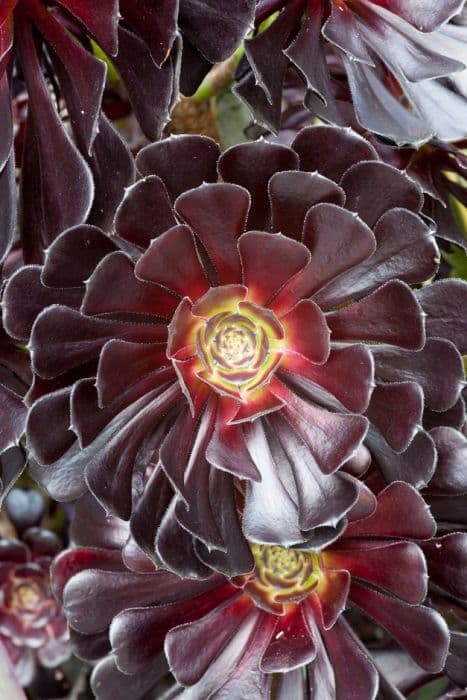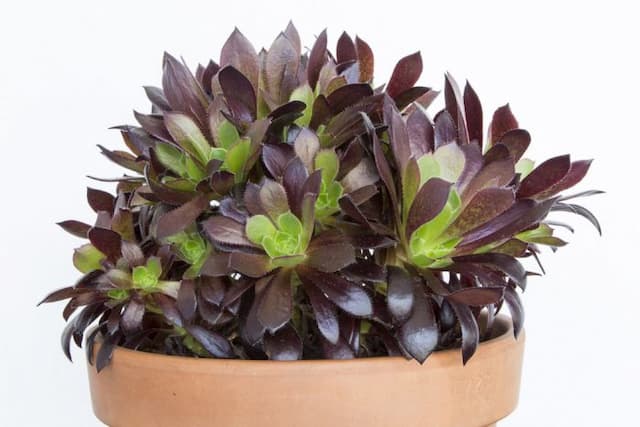Canary Island Aeonium Aeonium canariense var. subplanum

ABOUT
The plant known as Aeonium canariense var. subplanum is distinctive for its large, fleshy leaves which are arranged in a rosette pattern. These leaves are typically a bright, glossy green color and may have a slightly waxy or succulent texture, giving them a plump appearance. The edges of the leaves are smooth, and the leaves themselves are broad, contributing to the plant's lush, ornamental look. The plant's overall shape is somewhat sculptural, with the rosettes often appearing to stack on top of each other as the plant grows. This visual interest makes it a popular plant among enthusiasts and gardeners who appreciate unique and attractive foliage.
About this plant
 Names
NamesFamily
Crassulaceae
Synonyms
Canary Island Aeonium, Giant Velvet Rose
Common names
Aeonium subplanum, Sempervivum subplanum.
 Toxicity
ToxicityTo humans
The Aeonium, specifically Aeonium canariense var. subplanum, is not classified as a toxic plant to humans. However, as with many plants, if ingested in large quantities, it could potentially cause mild stomach discomfort or irritation due to the presence of saponins and other irritant compounds that are common in many non-toxic plants. It's important to note that while not considered poisonous, it's still advisable to avoid ingesting parts of this plant, as individual allergic reactions or sensitivities can occur. In general, the consequences of ingesting parts of this Aeonium are not severe, but caution should be exercised, especially with children and pets.
To pets
The Aeonium, specifically Aeonium canariense var. subplanum, is not typically toxic to pets. There is no well-documented evidence of toxicity in common pets such as dogs and cats. Ingesting parts of the plant might lead to mild gastrointestinal upset, such as vomiting or diarrhea, largely due to the plant's texture and the presence of saponins, which can cause irritation in some animals. If a pet were to ingest a large amount of the plant, it might experience more pronounced symptoms of gastrointestinal distress. However, under normal circumstances, the risks associated with this particular Aeonium to pets are low. Owners should still prevent pets from eating the plant to avoid any potential discomfort.
 Characteristics
CharacteristicsLife cycle
Perennials
Foliage type
Evergreen
Color of leaves
Green
Flower color
Yellow
Height
2 feet [60 cm]
Spread
2 feet [60 cm]
Plant type
Succulent
Hardiness zones
10
Native area
Canary Islands
Benefits
 General Benefits
General Benefits- Ornamental Appeal: Aeonium canariense var. subplanum, commonly known as the canary island aeonium, adds aesthetic value to gardens and homes with its rosette-forming succulent leaves and attractive structure.
- Drought Tolerance: This plant is highly adapted to arid conditions, making it an excellent choice for water-wise gardens and xeriscaping.
- Easy Maintenance: Canary Island Aeonium requires minimal care, making it ideal for busy gardeners or those new to plant care.
- Growth Habit: The compact size and controlled growth of the plant make it suitable for container gardening and small spaces.
- Sunlight Adaptation: It thrives in sunny locations, tolerating full sun to partial shade, and can enhance the variety of plant life in sunny areas of the garden.
 Medical Properties
Medical PropertiesThis plant is not used for medical purposes.
 Air-purifying Qualities
Air-purifying QualitiesThis plant is not specifically known for air purifying qualities.
 Other Uses
Other Uses- Aeonium canariense var. subplanum, known commonly as Canary Island Aeonium, can be used in thematic gardens, such as rockeries or xeriscapes, due to its succulent nature and resistance to drought.
- This plant's thick, fleshy leaves can be used in floral arrangements or boutonnieres for an exotic touch due to their unique rosette shape.
- Canary Island Aeonium's interesting geometric form makes it an excellent candidate for use in mathematical or geometrically-themed gardens, providing a natural representation of fractal patterns.
- Photographers and painters often use Canary Island Aeonium as a subject to capture the contrast between its rich green color and other elements in still life compositions.
- The plant can be a natural tool for teaching children about plant propagation, as its rosettes can be easily removed and rooted to grow new plants.
- In coastal regions, Canary Island Aeonium can be planted to add greenery and stabilize sandy soils with its root system.
- The succulent's rosettes can be used as a natural model for designing more efficient solar panels or other devices that mimic its radial symmetry for optimal sunshine capture.
- Because of its drought tolerance and ease of maintenance, this aeonium variety serves well in green roofing projects, which can help to reduce urban heat islands.
- As a part of sensory gardens, the thick leaves of Canary Island Aeonium provide a unique tactile experience for visitors who are encouraged to touch and feel the different textures of plants.
- Artists and educators can use the structural form of Aeonium canariense var. subplanum to illustrate the Fibonacci sequence and the concept of spirals in nature.
Interesting Facts
 Feng Shui
Feng ShuiThe Aeonium is not used in Feng Shui practice.
 Zodiac Sign Compitability
Zodiac Sign CompitabilityThe Aeonium is not used in astrology practice.
 Plant Symbolism
Plant Symbolism- Resilience: Aeonium canariense var. subplanum, commonly known as Canary Islands Aeonium, often symbolizes resilience due to its ability to thrive in rocky, challenging conditions on the Canary Islands.
- Endurance: This plant is known for its endurance, as it can survive long periods without water, representing the ability to withstand tough circumstances.
- Adaptability: The Canary Islands Aeonium adapts to varying light conditions, symbolizing flexibility and the capacity to adjust to different situations in life.
- Timelessness: A symbol of timelessness, this succulent retains its rosette-like foliage throughout the year, reflecting constancy and an unchanging nature.
- Beauty in Simplicity: With its simple yet elegant rosettes, the plant signifies beauty that can be found in minimalism and straightforward design.
 Water
WaterThe Canary Island Aeonium (Aeonium canariense var. subplanum) prefers infrequent watering, requiring a good soak only when the soil has completely dried out. During its active growth period in the spring and fall, water every 7 to 10 days, providing about half a gallon per plant for a medium-sized pot. In the heat of summer or the cool of winter, reduce watering to once every two weeks or less, monitoring the soil moisture levels. Always water at the base of the plant to avoid getting water on the leaves which can lead to rot.
 Light
LightCanary Island Aeonium thrives in bright, indirect light or partial shade. It does well placed by a window that receives filtered light or in a spot that gets morning sun and afternoon shade. Too much direct sunlight can scorch the leaves, while too little light can cause leggy growth, so it's important to find a balanced lighting condition for the plant.
 Temperature
TemperatureThe ideal temperature range for Canary Island Aeonium is between 65 and 75 degrees Fahrenheit. It can survive minimum temperatures of around 50 degrees Fahrenheit, but it should be protected from frost, which can be damaging. This succulent prefers a mild climate and does not do well in extreme heat, so it should be kept in a temperate environment to thrive.
 Pruning
PruningPruning the Canary Island Aeonium can improve its shape and encourage bushier growth. Prune in the early spring before the start of the growing season by removing any leggy stems or spent flowers. Pruning should not be overly frequent; once per year is usually adequate. Always use clean, sharp tools to make precise cuts and avoid damage to the succulent's fleshy leaves and stems.
 Cleaning
CleaningAs needed
 Soil
SoilCanary Island Aeonium thrives in well-draining soil mix with a pH of around 6.0 to 7.5. A mixture of one-third potting soil, one-third perlite or coarse sand, and one-third peat or another organic matter is ideal. This ensures that the soil remains aerated and does not retain excessive water, preventing root rot.
 Repotting
RepottingCanary Island Aeonium should be repotted every two to three years to ensure it has sufficient space to grow and to refresh the soil. This prevents the soil from becoming compacted and helps to provide nutrients for healthy growth.
 Humidity & Misting
Humidity & MistingCanary Island Aeonium prefers a dry to moderate humidity level, as it is native to arid environments. Ideal humidity levels are between 40% to 50%. Excessive humidity can lead to rot, so ensure good air circulation if grown indoors.
 Suitable locations
Suitable locationsIndoor
Place the Canary Island Aeonium in bright, indirect light indoors.
Outdoor
In sunny, warm climates, plant the Canary Island Aeonium outdoors.
Hardiness zone
9-11 USDA
 Life cycle
Life cycleThe life of Aeonium canariense var. subplanum, commonly known as Canary Island Aeonium, begins with germination from seed when conditions of warmth and moisture are met. Seedlings develop into a rosette of succulent leaves, which grows and stores energy for future reproduction. Vegetative growth occurs as the plant matures, with the rosette expanding and sometimes producing offsets or "pups" at the base, allowing for clonal propagation. Sexual reproduction takes place when the mature plant sends up a flowering stalk after a period of growth—usually several years; this stalk bears clusters of small, star-shaped flowers which, after pollination, produce seeds. Following flowering, the monocarpic rosettes die, but the plant may continue to live on through its offsets. Seed dispersal allows for the colonization of new areas, ensuring the continuation of the species' life cycle.
 Propogation
PropogationPropogation time
Spring-Early Summer
The Aeonium canariense var. subplanum, commonly known as the Canary Island Aeonium, can be propagated effectively through cuttings, which is the most popular method. To propagate by cuttings, a healthy leaf or stem is selected and cleanly snipped using a sterilized blade. It's crucial to let the cutting dry out for a couple of days until the cut end forms a callous, which prevents rot when planted. After the callous formation, the cutting is placed in well-draining soil, such as a mix of potting soil and perlite. The soil should be kept slightly moist but not soggy, and the cutting should be placed in bright, indirect light. It typically takes a few weeks for the cutting to root and establish itself as a new plant. This method is often performed during the plant's active growing season, which is typically spring or early summer.









